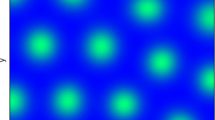Abstract
Based on the natural exponential pair potential \( U\left( R \right) = C{\text{e}}^{{ - {R \mathord{\left/ {\vphantom {R {\lambda_{0} }}} \right. \kern-0pt} {\lambda_{0} }}}} \), the interaction potential between curved surface body and on surface particle is studied. Firstly, the interaction potential is written as a function of curvatures through the differential geometry. Secondly, idealized numerical experiments are designed to test the accuracy of curvature-based potential. Then, the driving forces induced by curvatures are analyzed, which confirms that micro/nano-curved surface bodies can induce driving forces; curvatures and the gradient of curvatures are the essential elements forming the driving forces. Finally, by combining with the curvature-based potential and driving forces, the movements on surface particles and the evolution of surface morphology of curved surface bodies are predicted.

















Similar content being viewed by others
References
Zhou, G., Luo, L., Li, L., et al.: Step-edge-induced oxide growth during the oxidation of Cu surfaces. Phys. Rev. Lett. 109, 1–5 (2012)
Fang, X.F., Yan, L., Wang, D., et al.: Surface evolution at nanoscale during oxidation: a competing mechanism between local curvature effect and stress effect. J. Appl. Phys. 119, 1–8 (2016)
Veettil, S.K.T., Das, S.L., Balagopal, S.K.P.: Interplay of curvature sensing and generation mediated by peripheral membrane proteins. Biophys. J. 114, 614a (2018)
Draper, W., Liphardt, J.: Origins of chemoreceptor curvature sorting in Escherichia coli. Nat. Commun. 8, 14838 (2017)
Rosholm, K.R., Leijnse, N., Mantsiou, A., et al.: Membrane curvature regulates ligand-specific membrane sorting of GPCRs in living cells. Nat. Chem. Boil. 13, 724–729 (2017)
Wang, Y., Zhao, Y.P.: Eletrowetting on curved surfaces. Soft Matter 8, 2599–2606 (2012)
Wang, Z., Zhao, Y.P.: Wetting and electrowetting on corrugated substrates. Phys. Fluids 29, 041607–041863 (2017)
Lázaro, G.R., Dragnea, B., Hagan, M.F.: Self-assembly of convex particles on spherocylindrical surfaces. Soft Matter 14, 5728–5740 (2018)
Guan, Z., Wang, L., Zhu, X., et al.: Striped patterns self-assembled from rod–coil diblock copolymers on spherical substrates. Mater. Chem. Front. 1, 697–708 (2017)
Ma, L., Xu, S., Wang, C., et al.: Electrically modulated localized surface plasmon around self-assembled-monolayer-covered nanoparticles. Langmuir 33, 1437–1441 (2017)
Young, S.C., Gi, R.Y., Jong, M.L.: Self-organization of bidisperse colloids in water droplets. J. Am. Chem. Soc. 127, 15968–15975 (2005)
Cavallaro, M., Botto, L., Lewandowski, E.P., et al.: Curvature-driven capillary migration and assembly of rod-like particles. Proc. Natl. Acad. Sci. USA 108, 20923–20928 (2011)
De Boer, J.: Van der Waals in his time and the present revival opening address. Physica 73, 1–27 (1974)
Casimir, H.B.G., Polder, D.: The influence of retardation on the London-van de Waals forces. Phys. Rev. 73, 360–372 (1948)
Kralchevkky, P.A., Denkov, N.D.: Capillary forces and struvturing in layers of colloid particles. Curr. Opin. Colloid Interface Sci. 6, 383–401 (2001)
Israelachvili, J.N.: Intermolecular and Surface Forces, 3rd edn. Elsevier, New York (2011)
Irving, L.: The arrangement of electrons in atoms and molecules. J. Am. Chem. Soc. 41, 868–934 (1919)
Wang, D., Yin, Y.J., Wu, J.Y., et al.: Curvature-based interaction potential between micro/nano curved surface body and an outside particle. J. Comput. Theor. Nanosci. 12, 3206–3217 (2015)
Wang, D., Yin, Y.J., Wu, J.Y., et al.: Curvature-based interaction potential between micro/nano curved surface body and a particle on the surface of the body. J. Biol. Phys. 42, 33–51 (2016)
Chen, Y., Chen, S.: Potential functions of helium in molecular dynamics. J. Chem. Ind. Eng. 62, 1995–2000 (2012)
Freund, L.B.: Forced motion of an elastic filament through a narrow tube. Acta Mech. Sin. 31, 789–790 (2015)
Liang, J., Guo, Z.S.: Analytical modeling and simulation of porous electrodes: Li-ion distribution and diffusion-induced stress. Acta Mech. Sin. 34, 187–198 (2018)
Dong, Y., He, L.H.: Nonlinear analysis of photo-induced wrinkling of glassy twist nematic films on compliant substrates. Acta Mech. Sin. 31, 672–678 (2015)
Su, B.Q., Hu, H.S., Shen, C.L., et al.: Differential Geometry. People’s Education Press, Beijing (1979)
Wu, J.Y.: Biomembrane free energy and the driving forces induced by curvature gradients. [Ph.D. Thesis], Tsinghua University, Beijing (2012) (in Chinese)
Gall, J.G., Callan, H.G.: The sphere organelle contains small nuclear ribonucleoproteins. Proc. Natl. Acad. Sci. USA 86, 6635–6639 (1989)
Mycobacterium, S., Kuldeepkumar, R.G., Priyanka, B., et al.: Regulation of growth, cell shape, cell division, and gene expression by second messengers (p)ppGpp and cyclic Di-GMP in Mycobacterium smegmatis. J. Bacteriol. 198, 1414–1422 (2016)
Taylor, J.E.: The structure of singularities in soap-bubble-like and soap-film-like minimal surfaces. Ann. Math. 103, 489–539 (1976)
Acknowledgements
This work was supported by the Natural Science Foundation of Jiangsu Province (Grants BK20180411 and BK20180429) and start-up funding awarded by the Nanjing University of Aeronautics and Astronautics (Grants 56SYAH17065 and 90YAH17065), the Fundamental Research Funds for the Central Universities (Grant NS2018004).
Author information
Authors and Affiliations
Corresponding author
Rights and permissions
About this article
Cite this article
Wang, D., Yin, Y., Zhong, Z. et al. Surface evolution caused by curvature driven forces based on natural exponential pair potential. Acta Mech. Sin. 35, 445–456 (2019). https://doi.org/10.1007/s10409-018-0826-4
Received:
Revised:
Accepted:
Published:
Issue Date:
DOI: https://doi.org/10.1007/s10409-018-0826-4




